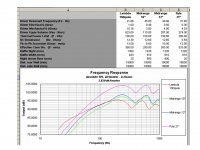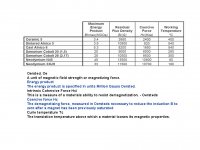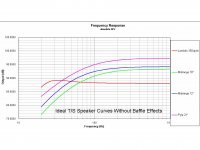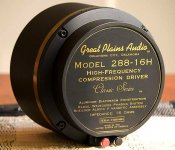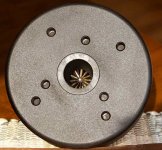Lynn Olson said:Thanks to Magnetar for the T/S measurements of the Pyle PDW21250 21" woofer. The averaged measurements of four samples are:
FS - 31.61
RE - 5.59
RES- 59.81
QMS- 4.03
QES- 0.38
QTS- 0.34
L1- 1.88
VAS - 274.29 liters
SPL - 95.4
I entered these values into the free XBaffle program, along with some fictional midrange designs which search for the best sounding and most usable dipole midrange T/S parameters.
Attachments
LineSource said:
I entered these values into the free XBaffle program, along with some fictional midrange designs which search for the best sounding and most usable dipole midrange T/S parameters.
Where can i find this XBaffle sheet anyway? I have googled it and the only thing that comes up are forum posts of others using it.
John
John_E_Janowitz said:
Where can i find this XBaffle sheet anyway? I have googled it and the only thing that comes up are forum posts of others using it.
John
http://www.t-linespeakers.org/downloads.html
Xlbaffle.xls
17/09/03
[692k]
Requires: MS Excel Version 5 or higher. Thorsten Loesch
Thunderstone Audio
Capabilities:
Calculates the T/S Parameter derived Sensitivity in db/2.83V/m for the 20Hz - 1kHz range for four individual Driver/Box combinations, including systems with two woofers and isobarik systems
Calculates influence of boundary loading effects
Calculates influence of Baffle Diffraction loss
NdFeB has high field strength and good resistance to demanetization. It's weakness is a 180C Curie temperature.
I hope more innovative NdFeB optimized ultimate home audio motors are designed and more golden ears get to review them. Most ProAudio NdFeB designs seem optimized for low weight.
I hope more innovative NdFeB optimized ultimate home audio motors are designed and more golden ears get to review them. Most ProAudio NdFeB designs seem optimized for low weight.
Attachments
LineSource said:
I entered these values into the free XBaffle program, along with some fictional midrange designs which search for the best sounding and most usable dipole midrange T/S parameters.
Ok, have a few questions here. I'm not sure exactly what you are comparing in here for dipole as baffle size is 100000mm. You also have different heights above the floor, etc. oh, as I'm typing I see you edited that now... so nevermind.
I did just put together a new underhung 15" midrange with standard parts we use. Efficiency can go up at the cost of Q dropping, but here is what I came up with for off the shelf parts.
Fs: 33Hz
Qts: .514
Qes: .53
Qms: 21.7
Re: 10.8 with coils in series
Le: .5mH
Vas: 280L
Mms: 74g
Cms: .315
Bl: 17.7Tm
1W SPL: 94.6dB
Now the interesting thing is that this is a dual 8ohm nominal coil. With coils in parallel we have about 2.7ohm DCR and 99.5dB 2.83V sensitivity. Throw that into the mix once. Both with the coils in series and coils in parallel. In parallel the Re will be 2.7ohm so the 2.83V goes way up.
Oh, also I forgot to mention this is an underhung midrange. Ruler flat Bl curve out to 3.5mm and then Xmax of about 5mm based on the Bl curve and .707 x rest value.
John
Pyle Xmax?
LineSource:
Looks promising, but where did you get the Xmax figure for the Pyle 21"?
Your figure sounds plausible, but just want to be confident (as Pyle's persistent lack of specs has not done much to inspire confidence)
-- Mark
LineSource said:
I entered these values into the free XBaffle program, along with some fictional midrange designs which search for the best sounding and most usable dipole midrange T/S parameters.
LineSource:
Looks promising, but where did you get the Xmax figure for the Pyle 21"?
Your figure sounds plausible, but just want to be confident (as Pyle's persistent lack of specs has not done much to inspire confidence)

-- Mark
Re: Pyle Xmax?
Hi Mark,
I got the 12 mm Xmax from a German diy website that has been discussing the Pyle 21" for a several months, but even this site also has no official Pyle manufacturer T/S data. I don't trust this Xmax number, and used it to just fill in a blank which has no effect on the shown graph. The Pyle home site has no datasheet. Even inputing Magnetar's measurements into Xlbaffle gave conflicting SPL_watt numbers. Personally I would guess that 12mm is Xmech.. the mechanical limit based upon the photos of the rear motor.. best to wait for more real measurements.
Plot of T/S specs without baffle effects.
Tubamark said:
LineSource:
Looks promising, but where did you get the Xmax figure for the Pyle 21"?
-- Mark
Hi Mark,
I got the 12 mm Xmax from a German diy website that has been discussing the Pyle 21" for a several months, but even this site also has no official Pyle manufacturer T/S data. I don't trust this Xmax number, and used it to just fill in a blank which has no effect on the shown graph. The Pyle home site has no datasheet. Even inputing Magnetar's measurements into Xlbaffle gave conflicting SPL_watt numbers. Personally I would guess that 12mm is Xmech.. the mechanical limit based upon the photos of the rear motor.. best to wait for more real measurements.
Plot of T/S specs without baffle effects.
Attachments
Now that the Great Plains Audio 414-16A's and 288-16A's have arrived, I'm on the verge of ordering a pair of Beyma SM-118/N's from US Speaker at US$150 each. The published 2nd and 3rd-harmonic distortion specs look good, the FR looks reasonably peak-free for a 18" woofer, and the T/S parameters are:
Fs = 36 Hz
Mms = 124 grams
BL = 18.3 N/A
Qms = 6.83
Qes = 0.53
Qts = 0.49
No = 2.5%
VC length = 18 mm
Air Gap Height = 7 mm
Xmax = 5.5 mm (peak in one direction)
Xdamage = 30 mm (both directions)
Sd = 0.115 sq. meters
Here's a quick question aimed at either John J or Nick McK: are there any plans for a Lambda 18" infinite-baffle driver with specs more or less in this ballpark? In a way, sort of a Hartley lookalike, with performance about midway between a true subwoofer and a high-performance long-excursion woofer?
P.S. The build quality on the Great Plains drivers is astounding, right down the traditional WECO/Altec black crinkle paint and the massive 20 lb Alnico magnets. With no bug screen, you can look right into the 288, and GPA is using a discreet dark gray on the Hendrickson phase plug instead of the original garish orange color on the Altec Tangerine phase plugs. A three-way comparison between the 414-16A's, 12NDA520's, and TD12M's should be very interesting - three radically different technologies in a similar format.
Fs = 36 Hz
Mms = 124 grams
BL = 18.3 N/A
Qms = 6.83
Qes = 0.53
Qts = 0.49
No = 2.5%
VC length = 18 mm
Air Gap Height = 7 mm
Xmax = 5.5 mm (peak in one direction)
Xdamage = 30 mm (both directions)
Sd = 0.115 sq. meters
Here's a quick question aimed at either John J or Nick McK: are there any plans for a Lambda 18" infinite-baffle driver with specs more or less in this ballpark? In a way, sort of a Hartley lookalike, with performance about midway between a true subwoofer and a high-performance long-excursion woofer?
P.S. The build quality on the Great Plains drivers is astounding, right down the traditional WECO/Altec black crinkle paint and the massive 20 lb Alnico magnets. With no bug screen, you can look right into the 288, and GPA is using a discreet dark gray on the Hendrickson phase plug instead of the original garish orange color on the Altec Tangerine phase plugs. A three-way comparison between the 414-16A's, 12NDA520's, and TD12M's should be very interesting - three radically different technologies in a similar format.
Lynn Olson said:Now that the Altec/GPA 414-16A's and 288-16A's have arrived, I'm on the verge of ordering a pair of Beyma SM-118/N's from US Speaker at US$150 each. The published 2nd and 3rd-harmonic distortion specs look good, the FR looks reasonably peak-free for a 18" woofer, and the T/S parameters are:
Fs = 36 Hz
Mms = 124 grams
BL = 18.3 N/A
Qms = 6.83
Qes = 0.53
Qts = 0.49
No = 2.5%
VC length = 18 mm
Air Gap Height = 7 mm
Xmax = 5.5 mm (peak in one direction)
Xdamage = 30 mm (both directions)
Sd = 0.115 sq. meters
Here's a quick question aimed at either John J or Nick McK: are there any plans for a Lambda 18" infinite-baffle driver with specs more or less in this ballpark? In a way, sort of a Hartley lookalike, with performance about midway between a true subwoofer and a high-performance long-excursion woofer?
P.S. The build quality on the Great Plains drivers is astounding, right down the traditional WECO/Altec black crinkle paint and the massive 20 lb Alnico magnets. With no bug screen, you can look right into the 288, and GPA is using a discreet dark gray on the Hendrickson phase plug instead of the original garish orange color on the Altec Tangerine phase plugs.
Hey Lynn,
When you get the chance, could you post some pictures of your new 288 drivers. I'd love to see them.
Rgs, JLH
I'll take some photos tomorrow. By the way, they are incredibly heavy, feeling like a solid 20 lb. brick of steel, which in a way they are. With the light just right, you can see right through the radial Hendricksen phase plug, and look at the slightly gold-colored diaphragm. Bill told me this is a thin enamel coating that GPA puts on the aluminum to prevent corrosion.
Still at a loss how I'm going to mount these things, with the right combination of repeatable and precise front-to-back adjustment and secure support of the cylindrical compression driver and the complex shape of the AH-425.
I've seen the photos on the French sites of the clever tennis-ball mounting scheme, but the prospect of the whole thing crashing down onto the floor, destroying itself as it goes, is too awful to contemplate. Some kind of U-shaped felt-lined wood cradle is the only thing I can come up with so far.
Still at a loss how I'm going to mount these things, with the right combination of repeatable and precise front-to-back adjustment and secure support of the cylindrical compression driver and the complex shape of the AH-425.
I've seen the photos on the French sites of the clever tennis-ball mounting scheme, but the prospect of the whole thing crashing down onto the floor, destroying itself as it goes, is too awful to contemplate. Some kind of U-shaped felt-lined wood cradle is the only thing I can come up with so far.
'Some kind of U-shaped felt-lined wood cradle is the only thing I can come up with so far.
Hello Lynn
That will work. You could just have a line scribed on one side and a ruler attached to the base it slides on. Figure you can use molding to make a "track" it can slide in and you can use the ruler to get "calibrated" front to back measurements that are repeatable. Once you get things all tuned up you can remove the ruler and "track" if you want.
Rob
Hello Lynn
That will work. You could just have a line scribed on one side and a ruler attached to the base it slides on. Figure you can use molding to make a "track" it can slide in and you can use the ruler to get "calibrated" front to back measurements that are repeatable. Once you get things all tuned up you can remove the ruler and "track" if you want.
Rob
Lynn Olson said:By the way, they are incredibly heavy, feeling like a solid 20 lb. brick of steel,
Still at a loss how I'm going to mount these things, with the right combination of repeatable and precise front-to-back adjustment and secure support of the cylindrical compression driver and the complex shape of the AH-425.
Some kind of U-shaped felt-lined wood cradle is the only thing I can come up with so far. [/B]
You are not kidding. I was surprised at both the size and weight when the UPS guy gave me these two big boxes of Altec 288. I have purchased the manual linear slide as mentioned in an earlier post. I think it is the best option for precise front-to-back adjustment.
Moreover, the RAAL tweeters are not light either. I think metal (steel) should be considered for the main frame. I am not sure what kind of clamps are required to mount the Altec to the metal frame.
Lynn Olson said:Here's a quick question aimed at either John J or Nick McK: are there any plans for a Lambda 18" infinite-baffle driver with specs more or less in this ballpark? In a way, sort of a Hartley lookalike, with performance about midway between a true subwoofer and a high-performance long-excursion woofer?
As soon as the surround is worked out, everything else is pretty much ready. We might end up having to get a new mold made for the surround to meet our needs.
agent.5 said:
Moreover, the RAAL tweeters are not light either. I think metal (steel) should be considered for the main frame. I am not sure what kind of clamps are required to mount the Altec to the metal frame.
I'm not entirely sure steel should be used for the frame of a loudspeaker, particularly a precision loudspeaker. It seems like steel might be capable of doing things to the magnetic fields of the drivers, which I don't think would be a good idea. Aluminum I-beams are quite strong and non-ferrous.
nickmckinney said:
As soon as the surround is worked out, everything else is pretty much ready. We might end up having to get a new mold made for the surround to meet our needs.
P.S. Have I mentioned you guys are the bomb?
JohnL said:
I'm not entirely sure steel should be used for the frame of a loudspeaker, particularly a precision loudspeaker. It seems like steel might be capable of doing things to the magnetic fields of the drivers, which I don't think would be a good idea. Aluminum I-beams are quite strong and non-ferrous.
I have no disagreement here, and I will pass the question to the speaker builders and experts on this thread. I was thinking that we need the thinnest frame, in order to not block the back waves of speakers.
New GPA 288 Alnico Driver - Front View
This photo shows the integral rubber gasket and the dark gray Henricksen phase plug with the aluminum diaphragm behind it. The bolt pattern provides either traditional 3-bolt or the modern 4-bolt pattern for 1.4" exit drivers.
The darkish area towards the lower right of the photo isn't actually on the driver - it's my shadow, since the late-afternoon sunlight is going nearly straight into the driver. The mounting plate and rubber gasket are not actually gray - that is an illusion due to the sunlight creating a specular reflection off the black paint and the surface of the gasket.
This photo shows the integral rubber gasket and the dark gray Henricksen phase plug with the aluminum diaphragm behind it. The bolt pattern provides either traditional 3-bolt or the modern 4-bolt pattern for 1.4" exit drivers.
The darkish area towards the lower right of the photo isn't actually on the driver - it's my shadow, since the late-afternoon sunlight is going nearly straight into the driver. The mounting plate and rubber gasket are not actually gray - that is an illusion due to the sunlight creating a specular reflection off the black paint and the surface of the gasket.
Attachments
- Home
- Loudspeakers
- Multi-Way
- Beyond the Ariel
